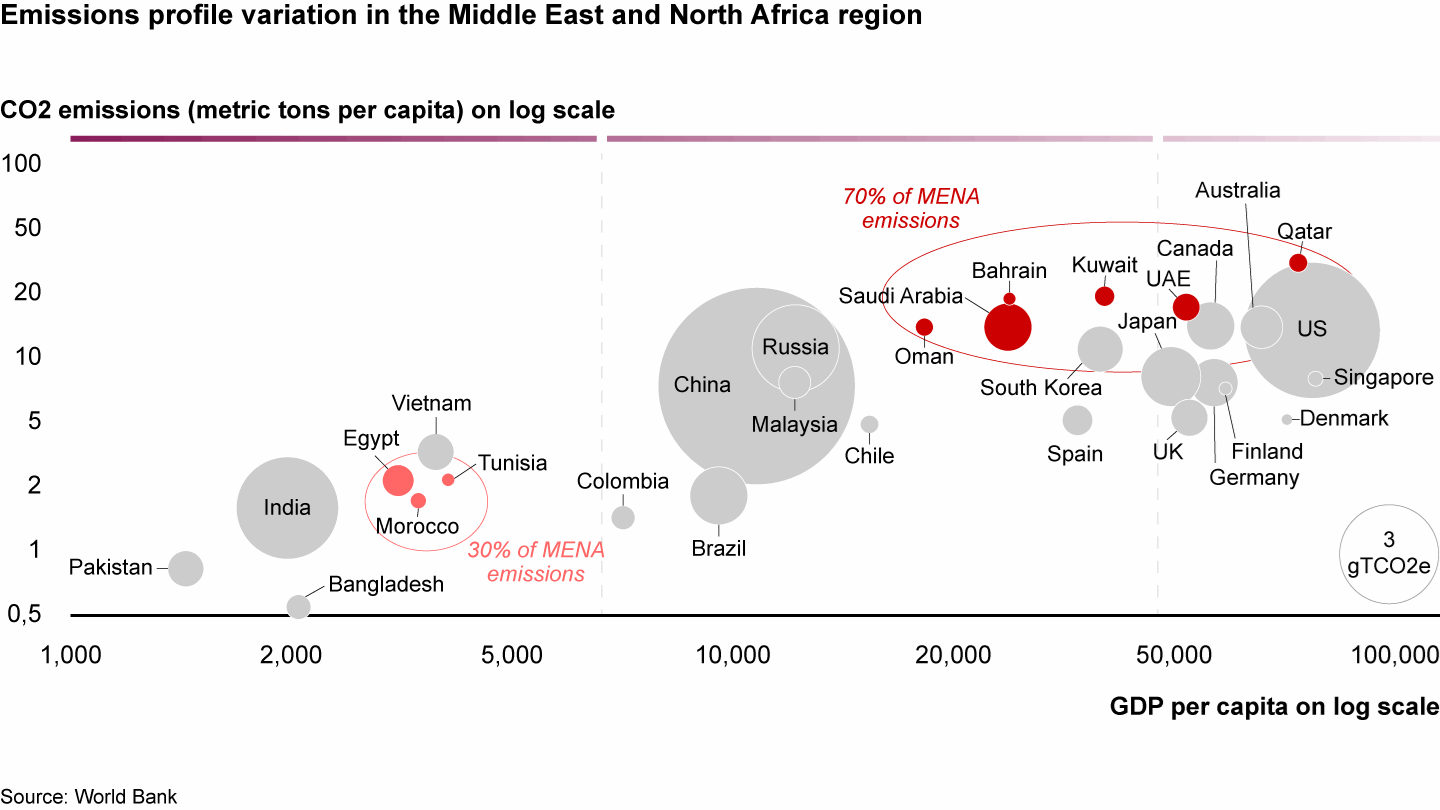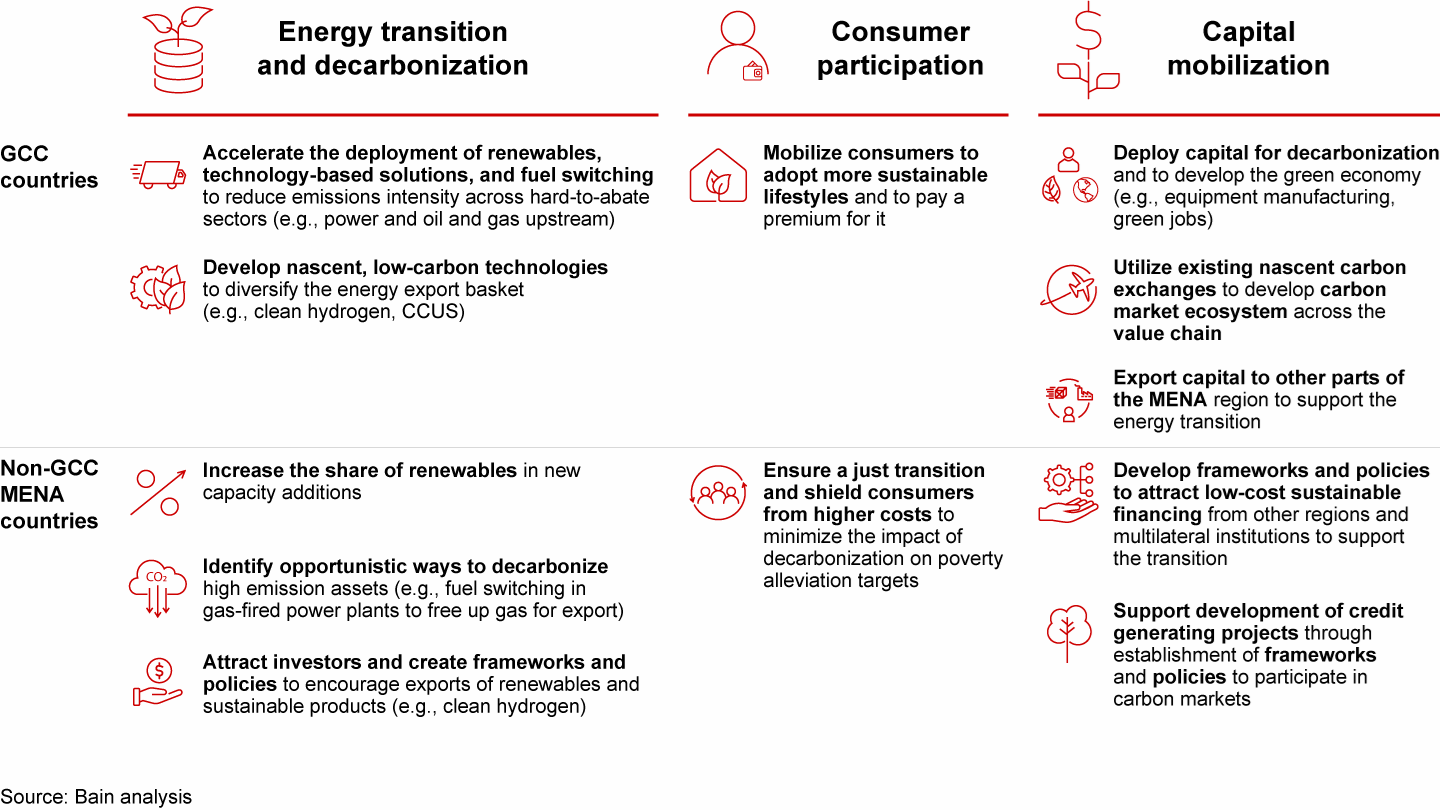World Economic Forum

Auf einen Blick
- The Gulf Cooperation Council (GCC) and non-GCC countries are two distinct groups within the Middle East and North Africa (MENA), with different emissions intensities and resource availability per capita. Those differences result in distinct priorities and opportunities for domestic decarbonization and energy export.
- For both groups, domestic decarbonization requires the rapid deployment of technology-based solutions, including energy efficiency, renewables, carbon capture, utilization, and storage (CCUS), and clean hydrogen.
- These technologies have the potential to generate significant energy and derivative exports, enabling the MENA region to maintain its role as a net energy exporter.
This article originally appeared on the World Economic Forum.
Technology-based decarbonization solutions are expected to be a crucial part of decarbonization in the Middle East and North Africa (MENA) because of the region’s climate and natural resources. However, there are crucial differences between the Gulf Cooperation Council (GCC) and non-GCC countries in the MENA region that result in different priorities in the energy transition journey. Countries and companies have to adopt strategies that reflect their specific energy mix, natural resource availability, and socioeconomic context, as well as the development needs of their populations.
Two MENAs
When looking at emissions intensity (emissions per person) and the resources available to pursue decarbonization (GDP per capita), the MENA region splits into two distinct subgroups (see Figure 1):
- GCC countries have higher income per capita and higher emissions intensity per capita, and account for 70% of MENA emissions.
- Non-GCC countries have lower income per capita and lower emissions per capita. They are responsible for the remaining 30% of the region’s emissions.


The subgroups also have different priorities for decarbonization and energy transition. GCC countries, for example, need to reduce the emissions intensity in hard-to-abate sectors, such as power and oil and gas, while protecting the population’s high standards of living and employment. GCC countries will continue to play a major role in the global energy value chain and develop new energy products and derivatives to diversify energy exports (e.g., clean hydrogen).
Meanwhile, non-GCC countries in MENA need to support decarbonization without creating barriers to economic growth and poverty alleviation. They can leverage the region’s significant potential for renewable energy to capture an upside from the global energy transition.
These critical priorities translate into specific strategic actions for GCC and non-GCC MENA countries (see Figure 2).


Decarbonization can create value in MENA
Energy and related sectors are the dominant sources of carbon emissions from the MENA region. The power and industrial sectors account for more than 50% of total emissions in MENA. Fugitive emissions from upstream oil and gas wells are responsible for more emissions than agriculture and buildings combined.
Energy transition and decarbonization in these sectors are crucial to pursuing net zero. Decarbonization also has an upside for GCC and non-GCC MENA countries: the opportunity to capture new value.
Opportunities in power generation
Power generation is the largest source of emissions in the region, accounting for one-third of total emissions. By gross, MENA’s power emissions are as high as the emissions for all of Saudi Arabia.
The power sector in MENA is characterized by:
- High dependency on oil and gas. Currently oil and gas account for almost 95% of electricity generation in the region, with roughly 20% from oil-based power generation.
- Lower-efficiency power-generation. Single-cycle gas power plants have relatively lower efficiency (30%–35%) compared to combined-cycle plants (50%).
- Low use of renewables. MENA has the highest solar potential globally as it receives 22% of global solar irradiance. However, solar deployment in the MENA constitutes only 5% of global capacity.
Therefore, the power sector should focus on three strategic priorities:
- improving the efficiency of current assets and shifting to combined-cycle gas turbines;
- using fuel switching to move away from oil-based generation assets; and
- deploying renewables at scale.
The emission intensity of the grid currently stands at 515 kilograms of carbon dioxide emissions per kilowatt hour, which is higher than the global average (441 kilograms of carbon dioxide emissions per kilowatt hour). If the power sector reduces emissions intensity and pursues these strategic priorities, it could unlock tremendous economic benefits. By switching from natural gas to renewables, the power sector could free up oil and natural gas for export to Europe and Asia. Exported oil and natural gas have an estimated revenue potential of $30–$35 per megawatt hour at current gas prices of $2.50–$3.00 per MMBtu.
The region’s national power companies could also export renewable energy by integrating the grids across South Asia, the Middle East, North Africa, and Europe, thus diversifying the energy basket.
Opportunities in oil and gas
Oil and gas production in the GCC region has one of the lowest upstream emission intensities (as measured by carbon dioxide emissions per barrel). Given the economic contribution it makes to the energy sector and the size and heft of various oil companies in the region, it is imperative for oil and gas companies to advance decarbonization.
However, upstream oil and gas production accounts for a low share of overall life-cycle emissions (about 12%). Refining contributes another 8% of emissions. The majority of upstream emissions (about 50%) are fugitive emissions. Thus, minimizing non-emergency flaring and managing upstream production emissions are imperative for decarbonizing the industry.
Oil and gas companies can:
- Adopt zero-methane flaring. Methane emissions trap 30 times more heat from the atmosphere than carbon dioxide and have very high global warming potential. In 2021, the International Energy Association estimated that flaring released 270 million tons of carbon dioxide and 8 million tons of methane (equivalent to 30 million tons of carbon dioxide emissions) into the atmosphere. While many countries in the MENA region have a zero-methane policy, targeted reduction of all non-emergency flaring is important.
- Deploy carbon capture and storage (CCUS) to reduce emissions from refining and other industrial processes. Given its geology, the MENA region has many natural sequestration sites. Many companies in the region have started to develop CCUS, and those efforts can be expanded. Saudi Aramco, for example, announced it will operationalize 9 million tons of CCUS capacity per year by 2027.
- Invest in R&D to reduce downstream emissions. The oil and gas industry will continue to play a major role in the global energy mix, retaining a 15% to about 50% share in various decarbonization and net-zero scenarios. Therefore, energy companies must minimize emissions from downstream activities as much as possible. The region’s energy companies can invest in making downstream usage, such as fuel combustion, more efficient. For example, higher-efficiency internal combustion engines in automobiles help lower emissions from transportation.
Beyond reducing emissions from energy’s value chain, these measures could unlock additional low-carbon derivatives such as green chemicals, green fertilizers, and green fuels (e.g., low-emissions diesel or gasoline). Green alternatives are expected to command significant premiums in the export markets and will diversify the region’s export mix.
Opportunities for new energy sectors
Companies across the world are racing to develop a clean hydrogen value chain, and governments are supporting them with enablement programs. For example, REPowerEU is the European Commission’s plan to increase hydrogen consumption to 20 million tons a year by 2030.
The MENA region can play a leading role in this upcoming energy sector, given its incredible solar potential. The cost to produce green hydrogen in the region is expected to drop as low as $1 per kilogram by 2035. Meanwhile, the region can produce blue hydrogen (conventional hydrogen coupled with CCUS) as a transitional variety at a low cost to seed the market.
Beyond decarbonizing domestic hard-to-abate sectors, clean hydrogen from the region can also be exported to Japan, South Korea, and Europe, where it is expected to fetch a significant premium. Early signs of collaboration are already visible. Saudi Arabia established the Green Hydrogen Company at NEOM, which plans to supply clean hydrogen to European buyers through NEOM’s joint venture partner, Air Products.
In addition, the region can enable financing for new energy vectors through the development of deeper carbon markets to facilitate transactions between buyers, such as large energy companies, and sellers, such as projects in breakthrough technologies like DAC of carbon credits, to develop an efficient flow of capital in the region to aid in the decarbonization journey.
MENA in the global picture
Given the global emphasis on the race to net zero and the role it can play, the MENA region is quickly becoming the center of the global decarbonization conversation. The region is preparing to host its second consecutive UN Climate Change Conference (COP) summit in the UAE later this year—and expectations are high for the region’s largest energy, power, and hard-to-abate industries. MENA companies are expected to demonstrate action on their decarbonization efforts. However, this is also a major opportunity for them to expand their energy baskets, advance critical national priorities, and expand global collaboration.